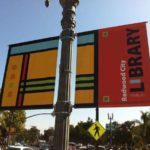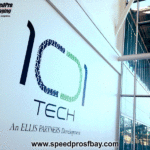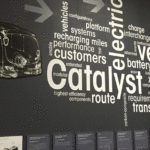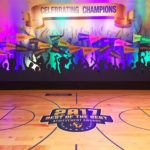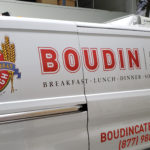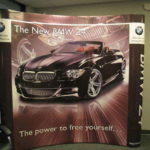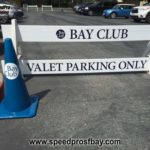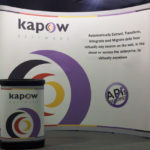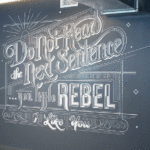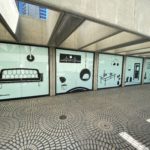General
-
HOW DO I GET A QUOTE OR PLACE AN ORDER??
-
To obtain information, a quote or to place an order, you can call, email or submit our online form.
Call: +1 (650) 662-5450
Email: info@speedprosfbay.com
Fill and submit: this
-
HOW CAN I PAY?
-
Generally, we don’t begin the process without a deposit of 50%, or a Purchase Order (PO) from your company to ours for the entire amount. We request full payment upon completion of the project and accept cash, check, and major credit cards which can be securely submitted online.
-
WHAT IS YOUR TURNAROUND TIME?
-
For most common jobs, once the artwork has been approved our turnaround time is generally 24-48 hours for production. For higher quantity and labor intensive projects, timing is worked out with the client directly.
-
HOW LARGE CAN SPEEDPRO PRINT?
-
At our San Carlos production studio, we can print banners and roll-to-roll media up to 10ft wide x 300ft long, as well as large panels. With foamboards, aluminum composite and other rigid substrates, the maximum size available is often 5ft x 10ft, which can be tiled together for larger displays. More commonly 4ft x 8ft panels are used for ease of transport and assembly.
-
DOES SPEEDPRO OF SF PENINSULA HAVE WHITE INK?
-
Yes! If white ink is required for a project, please give us a call.
-
HOW LONG DOES A PRINT LAST?
-
Depending on the substrate used and extreme environmental conditions, SpeedPro produced graphics can last almost indefinitely under indoor conditions. Outdoor applications, such as banners, can last several years, depending on finishing options like over laminates. Durability ratings are made available by the manufacturers and will vary depending on quality and type of material. Feel free to ask us about specific needs. All SpeedPro inks are resistant to fading from UV light but some colors hold their color depth better than others.
-
WHAT ARE SPEEDPRO'S TURNAROUND TIMES?
-
For most standard print projects, once artwork has been approved our turnaround time is generally 24-48 hours. For higher quantity or more labor intensive jobs, or if installation is required, timing is worked out directly with the client.
-
WHAT TYPES OF INK DO YOU USE?
-
We have three different ink sets we use in our large format inkjet printers Depending on the application, we use Agfa UV-curable ink, HP latex ink or eco-solvent ink. UV-curable inks allow us to print directly on almost any surface — foamboards, aluminum composites, wood, glass, carpet, ceiling tile, etc – and provide the option of white ink for spot colors or back flooding. Latex inks dry quickly allowing immediate lamination and stretch well, consequently making them the preferred option for vehicle graphics and many other adhesive vinyl prints. Eco-solvent based inks are aggressive and impregnate themselves into the surface of vinyl making them ideal for banners and many other materials. All our inks deliver a high quality, long lasting print with the most vibrant colors possible.
-
WHAT IS THE RESOLUTION OF YOUR PRINTING?
-
Our printers can print up to 720 x 1440 dpi, with standard print resolution of 720 x 720. In general for large format printing, greater nominal print resolutions may not yield better looking results, depending on the native resolution of the print file. A more important characteristic is the accuracy of inkjet dot positioning. Our Agfa Anapurna H3200i LED flatbed features eight 12-picoliter heads which guarantee printing of clean solids, fine text reproduction to 4pt and accurate tonal rendering.
-
CAN SPEEDPRO COLOR-MATCH?
-
Our inkjet printers use 6 colors of ink (+ white on our largest printer). Using the print primary colors; Cyan, Magenta, Yellow and Black with the addition of Light Cyan and Light Magenta (CcMmYK) allows us to reproduce an extremely wide range of colors. However, there are limitations to the color gamut and some colors are out of range. (for example: bright oranges, neon or metallic).
We cannot hit all spot colors exactly, but having a Pantone (PMS) reference number is very helpful as a target. If color matching is critical we can add a color matching step and create hard proofs for approval. Our color software (Asanti, CATZper, Onyx) and X-rite i1 spectrophotometer are key tools to achieve great color matching.
-
How does SpeedPro do Die cut or contour cut shapes?
-
The traditional method for cutting special shapes that were not just straight lines was to create a custom die which cut or stamped the paper. This is an expensive process that is fine for large volume production but a poor fit for short runs. While it is sometimes still referred to as “die-cutting”, what we actually do is more properly referred to as contour cutting. Using a computer-controlled plotter with a super-sharp blade, thin vinyl graphics can be “kiss-cut” for creating detailed decals, “Fat Heads,” vehicle lettering and more.
On a larger flatbed CNC system (such as our ESKO Kongsberg XN-24), we can cut large shapes in foam board, aluminum substrates, wood and acrylic. A vector format outline (which we can create) allows us to cut your graphic with computer precision without the need to make an expensive die.
IMAGE PREPARATION AND FILE SPECIFICATIONS
-
HOW DO I SET UP A FILE FOR LARGE FORMAT PRINTING?
-
We work mostly from Adobe Illustrator or Photoshop for large format printing so that’s a great place to start. You can submit your file as an .ai, .eps, .pdf, .tif, or .jpg. Please keep in mind when working with type that the layers of flattenend .tif and .jpg files cannot be edited, so if possible, outline the fonts before exporting and whenever possible use vector art.If you are providing your file in one the applications we support, be sure to include all fonts and graphics used in the document, as well as 1/8″ bleed if any part of your design is bleeding off the page. Some applications have a “Collect for Output or “Package” function that will do that for you. If that isn’t possible, follow the guidelines listed below:
INDESIGN:
• Convert all RGB colors and images to CMYK
• Package all fonts and graphics along with document, or
• Export as high-res EPS or PDFILLUSTRATOR:
• Convert all RGB colors and images to CMYK
• Convert all text to outlines
• Package all fonts and graphics along with document, or
• Export as high-res EPS or PDFCOREL DRAW:
Saving your Corel Draw file as an Adobe Illustrator EPS
• Convert all RGB colors and images to CMYK
• Embed all Images
• Convert all your text/copy to outline fonts
• Export as Illustrator EPS
-
HOW DO I SUBMIT FILES?
-
PDF (Portable Document Format) is the most common and preferred file format for submitting digital documents. With the installation of a PDF print driver on your computer, virtually any program can generate a PDF file suitable for printing. Both commercial and free PDF print drivers are available online for download from different sources.
Large files can be submitted through our ftp uploader. You can do this by selecting the “Upload File” button on the top of our web page and completing all necessary info in the form. If you’re more comfortable using an existing cloud service (Box, Dropbox, GoogleDrive, HighTail, WeTransfer, etc.) feel free to send us a link and we’ll download from there. Our graphics/print production team will make sure the files are complete and ready to print before proceeding. We’ll contact you with questions or advice as needed.
-
WHAT IS THE PANTONE MATCHING SYSTEM?
-
The Pantone Matching System (PMS) is a proprietary color reproduction standard in which almost 200 colors are each identified by a unique, independent number. The use of PMS allows printers to precisely match colors and maintain color consistency throughout the printing process. You can learn more here.
We cannot hit all spot colors, but having a Pantone reference number is very helpful and if requested, we’ll perform color matching and create hard proofs for approval if colors are critical.
-
WHAT RESOLUTION SHOULD RASTER (BITMAP) IMAGES OR SCANS BE FOR LARGE FORMAT PRINTING?
-
Unfortunately, this is one of those “it depends” situations. Unlike traditional litho printing or digital small format, we do not need 300 dpi photos. Often, images at 72 to 100 dpi at “size” (100% of the final printed dimension) are fine, and for large wall murals or banners, we can get by with less.
Small files (less than 1 megabyte) or .gifs downloaded from websites will usually result in pixelated, disappointing pictures when scaled up. For example, for a 24″ x 36″ poster at 72 dpi, the file would need to be 1728 x 2592 pixels or 4.5 megapixels. That’s about a 1 Mb .jpg file on a hard drive.
One issue that complicates this is that sometimes the properties of a file will show that it has, for example 300 dpi, but it may have simply been re-sampled at this resolution from a much lower native resolution. Thus, the image may be soft and lacking in definition even though it is technically at a high dpi. We’re always here to help, so if in doubt, we’ll take a look and let you know.
-
What's the difference between RGB and CMYK color space?
-
RGB refers to Red, Green and Blue, the primary colors of light. Computer monitors, LCD flat-screens, televisions, digital cameras and scanners use RGB to create images. CMYK refers to the primary colors of pigment: Cyan, Magenta, Yellow, and Black. These are the inks used in “4-color process printing”, often called “full color printing”, although there are color values that cannot be reproduced with the 4 pigment primaries.
The combination of RGB light creates white, while the combination of CMYK inks creates black. This difference between additive and subtractive color models means it’s physically impossible for the printing press to exactly reproduce colors as we see them on our monitors. RGB is able to display colors on screen that are not possible to create in CMYK.
At SpeedPro, all of the digital files to be printed go through printer-specific software (Raster Image Processor) that converts it to CMYK (+LightCyan and Light Magenta) instructions. So we can definitely print from RGB files. However the final printed image might not look quite as bright and saturated as it did on the monitor. So to best envision the end result, it is safest to adjust color in the CMYK color space.
Many programs can convert the layout/images from RGB to CMYK color spaces.
By doing it yourself, you have maximum control over the results. You may notice a shift in color when converting from RGB to CMYK. If you do not like the appearance in CMYK, make any needed adjustments working in CMYK (usually lightening). Be especially careful to keep backgrounds light if there is black or dark colored text over it, so that the text remains readable as layers of pigment (ink) will tend to ‘fatten up’ colors.
MAGNET SIGNS
-
HOW BIG CAN VEHICLE MAGNETS BE?
-
SpeedPro only uses .030 gauge magnet for vehicles since thinner ones (which may be fine for a refrigerator magnet) won’t stay put on the road. We can make magnets any size up to 36” high by 60” wide, but typical vehicle magnet sizes are as follows:
- 12″ high by 18″ wide
- 12″ high by 24″ wide
- 18″ high by 24″ wide
We can also make contour cut (shaped) magnets, or whatever dimensions you may need. Just ask.
-
HOW DO I CARE FOR VEHICLE MAGNETS?
-
Long-term use on surfaces frequently exposed to sunlight (such as vehicles) can result in uneven fading of the surface because the magnet-covered area is shielded from rays.
Installation
- When applying magnetic signs to your vehicle, check that the surface area of the vehicle is completely free of dust, dirt, grease, or other contaminates. A dirty surface will hinder adhesion and specks can be caught under the magnet and scratch the paint clear coat.
- If part of the vehicle surface contains Bondo or body filler, this will weaken adhesion.
- Magnetic signs will not adhere to vehicle surfaces that are of non-ferrous composition (e.g. aluminum, fiberglass, high-density plastic, etc.)
- Before affixing a magnetic sheet to a surface, be sure all surface paints, clear coats and waxes are cured. (Approximate curing time: paint – 90 days; clear coat – 60 days; wax – 2 days.)
- Order the proper size magnetic signs. They should not cover body moldings or grooves, nor extend beyond the contours of the vehicle.
Removal
- Be careful where you leave an unattended vehicle with magnetic signs. Sometimes vandals and wayward kids find them irresistible to swipe.
- Magnetic signs with dark background colors should not remain on a vehicle for extended periods during hot seasons.
- Your magnetic sign should be removed at least once a week.
Storage and Care
- Remove the magnet frequently and clean both the magnet and the metal surface. Use mild detergent; wiping with a soft cloth or allowing to air-dry. This will guard against moisture and dirt build-up between the magnet and the metal surface.
- Do not stack with magnetic sides facing each other as this will de-polarize them.
- Store the signs in a flat, dry and warm place.
- Don’t fold or bend mag signs as this may result in permanent damage. They must remain completely flat. Bends or bubbles in the magnetic signs may allow air to lift the magnet from the surface of the vehicle.
- If slight folds or creases occur by accident, lay the magnetic signs down on a flat surface and soften with the heat from a blow dryer.
- There are a number of steps to follow in order to ensure that your magnetic signs stay in good shape. For this reason, it is not possible to offer any guarantees on lost, stolen, or damaged magnetic. SpeedPro’s warranty extends only to the adhesion of our vinyl graphics to the surface of the magnetic material. However, by following the above noted guidelines your magnetic sign should last a long time!
BANNERS
-
What banners does SpeedPro offer, and how do I know which to choose?
-
SpeedPro banners include:
- Vinyl Banner
- Fabric Banner
- Paper Banner
- Full Color Banner
- Smooth Banner
- Mesh Banner
- Scrim Banner
- Double-sided Banner
- Back lit Banner
- Custom Banner
- Outdoor Banner
- Pole Pocket Banner
- Business Banner
- Retail Banner
- School Banner
- Banner Stand
- Retractable Banner
At SpeedPro in San Carlos, we print up to 10 feet high by 150 feet wide if needed. Most banners can be printed on either matte or gloss material, smooth, scrim or mesh as desired. If you have questions on what material or style is best for your needs, please let us know and we’re happy to offer suggestions.
-
How do you measure for a pole pocket or street banner?
-
For street or boulevard banners, many cities and towns have their own regulations which will vary depending on the particular location. Check local municipal codes regarding sewn-in rope, reinforced corners, nylon webbing in hems, grommet placement and wind relief. Although some of the requirements may seem arbitrary or antiquated, SpeedPro can produce to the required specs. As the saying goes, ‘you can’t fight City Hall”.
Pole pocket sizing is based on the flattened height of the pocket. In other words, a 3” pocket opens up to a 6” circumference, which To calculate sizing for the pole pockets, we suggest you allow for at least 2.5 times the diameter of your pole.
-
Are wind-slits or vents in banners helpful?
-
The short answer is NO. Wind vents are a series of cuts (usually semi-circular ‘U’ shaped or “V” shaped) made in a banner in the mistaken belief that this relieves or reduces wind resistance. The effectiveness of wind vents has been thoroughly disproved by science, but they are still required in many towns and cities for street banners. See our blog: https://www.speedpro.com/san-francisco-peninsula/mesh-banner-blows-away-wind-slits/, or for a very good explanation of the science, check out this article.
-
Will my banner meet fire codes?
-
Our standard and blockout scrim banner materials meet NFPA 701. Documentation of test results is available from the manufacturer’s website.
DECALS, EVENT BADGES AND SPECIALTY LABELS
-
Can you create custom shaped decals?
-
Yes, whether large or small, we can create contour cut adhesive vinyl decals with lamination or not. When the digital art is set up, we will generally need a cut line (or die line) indicated in the file. This is often on a separate layer and the art should extend or bleed beyond the edge of the cut line.
-
How to personalize event badges with attendee names?
-
If SpeedPro is producing your single or double-sided event badges, we can utilize variable data to print the attendees name and company information on the badge. Please work with you SpeedPro customer service rep who will take you through all the required steps for setting up names in a spreadsheet as well as the data fields on the badge template.
-
Can decals be permanent or removable?
-
Sure. We can make decals from many types of pressure sensitive vinyl. So depending on needs, ask us about changeable adhesive, removable adhesive or permanent adhesive.
-
Do you print decals on metallic or reflective material?
-
Yes. There are a variety of specialty media available which can be printed upon. This includes metallic (polished, brushed, swirled, etc.), day-glo, reflective and textured finishes.
Vehicle Wraps
-
What is a Vehicle Wrap?
-
A partial or full vehicle wrap acts as mobile billboard advertising your business 24 hours a day while simultaneously increasing brand awareness everywhere you drive. Full wraps (with optional ceiling wraps for trucks) cover the entire visible surface, and partial wraps will cover some and may be augmented with decals in other areas.
Wraps are made using custom-printed, high quality specialized adhesive vinyl that is laminated with a protective coating, giving the vehicle luster, gloss or matte finish. Once the graphics are created, the vinyl is applied and helps protect the vehicle’s original paint.
Vehicle wraps can be easily removed (or changed!) even several years after installation, returning your car back to its original color.
-
Will a Wrap Damage My Car’s Paint?
-
Vehicle wraps do not generally damage a car’s factory paint job- they protect it!
If your vehicle’s paint is in poor condition when wrapped, it may peel when the vinyl is removed. On the other hand, if your vehicle is freshly painted or brand new, we recommend waiting several weeks to give the paint time to cure.
-
Can You Wrap a Leased Vehicle?
-
Yes, SpeedPro wraps a lot of leased commercial vehicles. However, we always suggest double checking first with your leasing agent.
-
What is the Best Base Color for a Vehicle Wrap?
-
SpeedPro can wrap any color car, truck, van or bus.
-
Can a Wrap be Partially Changed and/or Repaired?
-
Yes. If your business’ phone number or email changes, overlay graphics can be created and applied directly on top of your exiting wrap. Similarly, if your wrap is partially damaged, we can repair or replace the affected area with new vinyl to match the existing graphics. Generally, since wraps are printed and applied in large sheets, we will need to replace a large section, especially if there has been body or collision repair work done.
-
What Accreditations Does SpeedPro have?
-
SpeedPro of SF Peninsula has a partnership with 3M giving us access to better pricing than most other large format printers
-
Why Wrap or do a Decal Package on a Fleet Vehicle?
-
As one of the most cost effective forms of advertising, vehicle wraps and graphics are a powerful marketing tool that helps your business connect with customers on the go. The cost per impression, or CPI, of vehicle wraps is much less than traditional forms of advertising like TV and radio.
Vehicle wraps with successful branding and high resolution graphics are proven to increase brand awareness up to 48% more than simple vehicle lettering alone.
-
What do Wraps Cost?
-
Generally, a full vehicle wrap costs between $2,500 and $6,500 but pricing varies depending on several factors. These factors include:
1. The vehicle size (amount of material required)
2. The complexity of installation
3. The duration of the design phase
4. The quality of the vinyl and laminate
We often work with companies to design a solution that maximizes impact while reducing costs. Please let us know if you have a target budget and we can develop a partial wrap or decal package to deliver maximum “bang for the buck.”
-
Are Wrinkles Normal?
-
Yes, the occasional small wrinkle is normal due to the complex shape and curving of different vehicles. However, when a wrap is professionally installed, small imperfections, like a wrinkle, won’t be visible to the naked eye. Before we wrap any vehicle, we provide a guide that helps set expectations and explain that small imperfections, relief cuts, seam overlaps and exposed hinges are normal for commercial fleet graphics.
-
Can I Wrap a Vehicle by Myself?
-
Installing a vehicle wrap is a difficult process that should only be done by a trained professional. The vinyl material can be easily damaged during the install and air bubbles can be trapped beneath the surface creating visible imperfections. Having a skilled installer do the work up front ensures that your wrap will look impeccable and last for years to come.
-
How Do I Care for a Wrap
-
General Guidelines:
- Use only soft towels and mild soap when washing your car.
- Do not use any corrosive cleaning solutions on the vinyl.
- Only visit brush-less car washes, avoiding high-pressure washes.
- Wait at least one week after installation to wash your car, giving the vinyl time to properly adhere to the vehicle.
- If your wrap includes window graphics, wait at least three days to roll down the window.
- If your back window is wrapped, remember not to use your rear window wiper as it may damage the wrap or leave a mark after being used.
Specific Guidelines
1. Wash Regularly
- Rinse off as much dirt as you can with water before using soap.
- Use a mild, non-abrasive soap like 3M Car Wash Soap 39000 and a soft sponge or cloth
- Rinse off all soapy water and use a squeegee to reduce the chance of water spots developing.
2. Automated car washes are not recommended as the brushes can scuff and abrade the vinyl, leading to possible chips and lifted edges.
3. Brush-less car washes are acceptable
4. Pressure washing
- Hand washing is preferred to pressure washing. However, pressure washing can be used under the following conditions:
- The water pressure must be kept below 2000 psi (14 MPa)
- The water temperature must not exceed 80°C (140°F)
- Use a nozzle with a 40° wide angle spray pattern
- Keep the nozzle at least one foot away and at 90° to the graphic being cleaned
5. Difficult contaminants
- Remove difficult contaminants by soaking the affected area for several minutes with very hot soapy water and rinse thoroughly. If additional cleaning is required, use a non-abrasive cleaner and remember to test an inconspicuous area first.
6. Polish and wax
- Most wraps can be polished or waxed if using a high-quality car wax. Don’t forget to test a small inconspicuous area first.
- We do not recommend using polish or wax on any matte finish or textured vinyl.
-
What About Color-Change or Carbon Fiber Wraps?
-
We generally do not do what are known as “color change” wraps. SpeedPro specializes in large format printing and display graphics for marketing, information and communication, whereas color change wraps are really a “car customization” project. The installation process for solid color wraps for personal cars is significantly more labor intensive than commercial wrap or decal package.
-
Can Vinyl Wraps help me cover up rust or chipping paint?
-
Unfortunately, no. Wrap vinyl and lamination are only 4/1000-inch-thick, so if any part of the vehicle to be wrapped feels rough to the touch, that scratch, spot or imperfection will be visible through the vinyl. We recommend having any necessary body work completed before the install.
-
Is There Anything You Cannot Wrap?
-
We don’t recommend wrapping plastic, especially textured plastic. We also don’t wrap extremely curvy objects like helmets. On commercial vans, we generally do not wrap any protruding hinges that may be on rear doors.
-
How Are Windows Wrapped to Look Like Part of the Design?
-
Rear and side windows (behind the front seat) can be wrapped with printed perforated film, or “Window Perf”. Window perf vinyl is perforated with very small holes that allow you to see out. Inside the vehicle looking out is similar to a tinted window. From the outside, the graphic is visible. We use an optically clear over-laminate on all window perf to protect the image from damage.
-
How Long Will a Commercial Vehicle Wrap Last?
-
There are many variables that affect longevity. Printed graphic wraps generally have a 5-7 year durability, but the amount of exposure to sun and dew plays a large part in the life span of the materials. Horizontal surfaces (such as the trunk, hood and roof, hood) that are exposed to UV rays and acid buildup from dust and dew will greatly be reduced to about 1 to 3 years. Window perf may only have an outdoor durability of about 1 year. Regular maintenance (washing, waxing) and garaging the vehicle will greatly improve the life of the vinyl.
THE TERMINOLOGY OF GREAT. BIG. GRAPHICS.
-
What is Large Format or Grand Format Printing?
-
SpeedPro starts where most print shops leave off. We specialize in producing large graphics including vehicle wraps, trade show displays and exhibits, full color outdoor banners, Generally, large format (or wide format) is printing to media wider than 2 feet (~2ft to 6ft often). Grand format (or super wide) is the term most often associated with widths greater than 100”
-
WHAT ARE THE OPTIONS AVAILABLE FOR ADHESIVE?
-
No Adhesive
Banners, photo paper, poster paper, and artist canvas typically do not have any adhesive.
Repositionable
Repositionable graphics have a low-tack adhesive that leaves no residue and can be reused like “Fat Heads.” Recent additions to this class of adhesive include “micro-dot” adhesive which allows easy application by non-professionals.
Changeable
Changeable films can be removed without any aids such as heat or chemicals and without leaving adhesive residue.
Semi-permanent
Some semi-permanent films can be removed with the aid of heat only. Others may require chemicals or accessories. These films leave less than 30% adhesive residue that can also be removed. Vehicle wraps are semi-permanent.
Permanent
Permanent films are not designed to be removed. In some cases they can be removed, but with great difficulty and likely damage to the substrate or surface. When removed, they may leave significant adhesive residue. Decals and signage typically use permanent adhesives.
Static Cling
Designed for short-term indoor window or mirror graphics. Static cling graphics are repositionable and reusable and rely on surface tension rather than adhesive to “stick” to glass.
-
What do you mean by Media?
-
Media in our world isn’t the news business or TV networks, but rather the material that your graphics are printed on. SpeedPro prints on many different types of media including banner material, adhesive backed vinyl, paper, fabrics, film and many others.
-
What kinds of media are available?
-
Artist Canvas
We use specially coated canvas with our big inkjet printers to print canvas that can be stretched on wooden bars for “gallery wrap” or framed pictures. With its subtle weave the look of real canvas is unmistakable.
Banner Vinyl
This printable, durable, flexible and fade resistant material will withstand most weather conditions. Vinyl banner material is available in a variety of scrim, smooth, and mesh constructions for front-lit, backlit or blockout uses. The thickness of the media generally increases strength and is generally measured in ounces – e.g., 13 oz. It’s a hard to decipher system, so we’re happy to advise.
Calendered Vinyl
General-purpose pressure sensitive vinyl (PSV) for signs and graphics which provides moderate to good exterior durability. Calendering is the manufacturing process of rolling vinyl to thinner and thinner gauges, (like rolling pie dough or homemade pasta) and this less expensive production methodology keeps costs down. Stiffer/thicker film provides easier handling. Since calendered films have less ability to conform, they are intended for application to flat, smooth, opaque surfaces.
Cast Vinyl
High-end premium or high-performance vinyl is “cast” – a more complicated and expensive manufacturing process that results in a superior product. Designed for maximum outdoor durability and conformability, cast media also tend to maintain color and dimensional properties better than other vinyl films (less shrinkage). Cast films can be made very thin which produces a conformable product that allows application over substrates with compound curves, rivets and corrugation. Cast vinyl is excellent for both flat and irregular opaque application surfaces and vehicles.
Etched or Frosted Vinyl
This adhesive vinyl simulates the appearance of etched or sandblasted glass on window fronts, entry doors, and partitions.
Metallic Vinyl
We stock basic varieties and can order a wide range of metallic vinyl — silver, gold, copper and bronze. They are available with different textured and finishes including mirror-like polish, brushed, hammered, swirled and other specialty-textured effects.
Non-Adhesive Opaque Films
For printing scientific and medical presentations or posters, a wide range of printable synthetic films are available. We stock blockout matte film, high-gloss polypropylene film, and smooth anti-curl material used in retractable stands and other retail point-of-purchase displays.
Perforated Window Film
Available in the classic 50/50 for vehicles, perforated window film is commonly seen on bus wraps, trains and car wraps to carry an image across windows while allowing passengers to still see out. For retail applications we often suggest 60/40 or 70/30, where the print area (the first number) is higher and outward visibility for safety is not an issue. 50/50 is the maximum density allowed on cars.
Photo Paper and Poster Paper
High gloss “photo” paper is available for creating digital “C-prints” and other oversized glossy pictures. We also stock matte and satin poster papers of various weights from 6mil to 11 mil (approx. 40# cover to 100# cover equivalent)
Polyester Fabric
Depending on the use case, we can print fabric on our latex or UV printers, or provide dye-sublimated prints on stretch polyester. Polyester is lightweight and versatile and resists wrinkling. Small wrinkles in portable display properties can be steamed out with a portable hand steamer.
Reflective Vinyl
Ideally suited to safety and commercial signs or vehicle graphics that require viewing both day and night, reflective vinyl is available in pre-colored or print-ready types.
Static Cling
Available in clear or white, traditional static cling relies on the surface tension of glass to hold the material to the surface without the use of adhesive.
Street Graphics
Unique materials such as AlumaGraphics and AsphaltArt are great (but rather expensive) solutions for street graphics on pavement and concrete. We also offer specialty adhesive vinyl intended for outdoor use such as StreetRap, which features a very aggressive adhesive to bond to cement or blacktop.
Translucent Film and Vinyl
For illuminated signs and backlit displays, we stock translucent film (no adhesive) and adhesive backed vinyl. These materials are designed to provide vivid colors and maximum light transmission for “digital duratrans” inserts.
-
What is Substrate?
-
Although some printers refer to all print materials as substrates, we specifically use the term to refer to rigid material (in contrast to the flexible media).
Depending on your project, we have the option to print directly on our UV flatbed printer, or print on roll material and mount to the substrate
-
WHAT KINDS OF SUBSTRATES ARE AVAILABLE?
-
Acrylic
Available either as cast or extruded, acrylic (often called plexiglass) is lightweight, high optical quality, high impact strength, and excellent weather ability. We work with both colored and clear acrylic in various thicknesses.
Card stock and E-flute board
Although we don’t commonly use these, we can produce large format prints on various cardboards and card-stock from chipboard to e-flute corrugated. We can source C-flute (3/16”) and E-Flute (1/8”) in 4’x8’ sheets, but generally get other card stock or chipboard in “parent size” sheets (generally 26” x 40”).
Corrugated Plastic – aka “Coroplast”
Corrugated plastic is the familiar material commonly used for lawn signs, A-frame inserts and other rugged, outdoor uses. The fluted corrugation allows for the use of ‘H’ shaped stakes for ground level signs and dowels on the thicker (10mm) variety. Corrugated plastic is inexpensive, relatively durable, water-proof and resistant to stains and most chemicals. It can be printed on directly or used for mounting vinyl, and is also offered in a wide range of stock colors. The most common thickness is 4mm; 10mm is rigid and heavier.
Coroplast is a brand name of corrugated plastic substrate that is a registered trademark of Inteplast Group. Because of the awareness of this brand, many people today generically refer to all corrugated plastic as “coroplast”
Display Board (Gatorfoam, Ultraboard, etc.)
“Gator” and Ultraboard are similar in construction and thickness to foamcore, but are significantly more hearty and durable. Ultraboard (identical to Gatorplast) features a litho-grade, high-impact polystyrene surface for permanent displays and signs. Ultraboard is designed primarily for interior use, but can be used outdoors, and it is durable. Dent-resistant styrene liners are secured to the foam center with a bond that keeps the panel flat and rigid. Moisture does not penetrate, but it is not intended for prolonged outdoor use. SpeedPro stocks Ultraboard in white and black.
Eco-friendly Options
Our go-to option for sustainability is Falconboard, a brand of rigid substrate from Hexacomb. Falconboard is 100% paper-based, offers excellent rigidity and compression strength and is completely recyclable. It comes in thicknesses ranging from ¼” to 1”, with either a white or kraft fill.
Expanded PVC (Sintra)
Expanded PVC is lightweight, rigid board of moderately expanded closed-cell polyvinyl chloride (PVC). Featuring a low gloss matte finish, it is great for direct printing. We stock thicknesses including 1mm, 2mm, 3mm and 6mm. Suitable for display, exhibit, interior, or exterior signage and for photo mounting. While more durable than foamcore or display boards, expanded PVC does not have the rigidity of those, which can be an advantage if needed to curve pieces for a podium or exhibit display. The 3mm or thinner material can be heated and molded. Sintra is popular brand name and often used generically.
Foamcore
Foamcore is a lightweight, paper-faced foam board. Made from extruded polystyrene foam clad on both sides with heavy white or black smooth coated paper. Our most common thicknesses in stock are 3/16” and ½”, but it can be ordered in ¾” or 1” as needed. Typical boards are 4 feet x 8 feet, but we also offer 5 feet x 10 feet. Best for interior mounting applications requiring rigid, lightweight, and relatively inexpensive material. Generally, foamcore is utilized for short-term needs as it dents readily, can warp with moisture and does not adhere well to certain glues.
Magnetic Sheeting
Magnetic sheet material is used primarily in vehicle magnetic signs, but has many other possible uses. Vehicle magnetic signs are typically .030″ thick, but thinner sheeting can be used for refrigerator or display magnets. At SpeedPro of SF Peninsula, we can print up to 48” wide roll material, although most magnet signs are smaller.
MDO Sign board
Medium Density Overlay (MDO) is an exterior grade, specialty plywood product. Since it features waterproof glue and a weather-resistant layer of resin infused fiber to protect it from elemental damage, it is a favorite of sign makers. We can either direct print or mount with laminated vinyl.
Polycarbonate
Polycarbonates are a particular group of thermoplastic polymers — lightweight, high impact strength and excellent weather ability. Available in clear and white. Primarily known by the trademarked names Lexan, and Makroclear, polycarbonate is easily worked, molded, and can be thermoformed. Like acrylic, polycarbonate is excellent for backlit signage and other interior or exterior displays. There are various advantage/disadvantage trade offs between polycarbonate and acrylic in signage, and we’re happy to help lead toward the best depending on usage.
Poly-metal Panels
Sometime called ACP, these panels are designed to provide the rigidity and strength of an aluminum sign without the weight or expense. They consist of either solid, honeycomb or corrugated plastic core with aluminum laminated to both surfaces. They can be cut and routed, offer excellent durability in outdoor applications, and are available with white or metallic surfaces. Alumalite, Alumacor, are popular brands of the corrugated type. Dibond and MAX-Metal are popular brands of the solid polyethylene core type used in the sign industry.
Styrene
Styrene is a type of thermoplastic material used primarily as an indoor panel or for outdoor usage up to 1 year. Styrene provides a terrific, smooth surface for printing and is relatively sturdy and inexpensive, but can get brittle in direct sunlight and is not recommended for long-term exterior signs.
-
WHAT IS OVERLAMINATE?
-
Overlaminate (usually just called laminate) is a thin film layer applied on top of media to further protect the graphic or enhance the look. We generally use a cold lamination film process (with available heat assist as needed). The laminate finish — from matte to high gloss — can be selected based on taste and the nature of the project.
Glossy finish lamination tends to make prints look more vibrant. Matte and Luster finishes help prevent unwanted glare (a key issue for trade show exhibits or scenic backgrounds used on camera) but do not affect color.
We also use liquid laminates on certain applications such as wall coverings.
-
WHAT TYPES OF LAMINATE ARE AVAILABLE?
-
Anti-graffiti
Anti graffiti laminates provide excellent resistance to chemicals and solvents. They allow for removal of graffiti and other markings, but some ghosting may remain, depending on the severity of the vandalism.
Dry Erase
Dry erase laminates turn any sign into a dry erase surface. Great applications include maps, menus, business presentations, and leader boards.
Floor
Anti-skid laminates provide a slip-resistant surface for floor and street graphics. (UL classified #4R93 for slip resistance)
Gloss/Satin (Luster) /Matte
Everyday laminates provide a high level of UV protection. They also protect prints from moisture and abrasion. Laminates can also be used to enhance the depth of the image. We match cast lamination for cast vinyl and calendered lam for calendered vinyl.
Polycarbonate
Polycarbonate laminates provide scuff and UV resistance. They also provide rigidity and durability to presentation graphics, displays and decals.
-
WHAT IS THE DIFFERENCE BETWEEN CAST AND CALENDERED VINYL?
-
Though cast vinyl and calendered vinyl look the same they have some very fundamental differences that are established during their manufacture that yield specific performance characteristics. These characteristics make each type better suited to particular projects. In general, cast vinyl is the “high-performance” option; more expensive, more malleable and best suited for vehicle wraps and long term signage. Calendered vinyl is the “everyday” option, less expensive but still excellent for flat surfaces and short to medium term signs, decals and posters.
Calendered vinyl gets its name from the manufacturing process It is created from a series of basic raw materials which are run through a series of calendering rollers once it reaches a molten state. The process of being fed through these heavy rollers is like an industrial version of making pasta with a home pasta machine, as the material is flattened to thinner and thinner caliper. This process is great for high volume vinyl projects as it is efficient and produces high yields of vinyl. The disadvantage of this process is that due to the original state as a ‘ball’ of material that is flattened, the vinyl retains a shape memory, and when exposed to heat tends to slightly shrink. This ‘dimensional instability’ is subtle and makes calendered vinyl ideal for shorter term projects – especially “intermediate” polymeric vinyl. Calendered vinyl is thicker and less able to be stretched and conformed over curved surfaces than cast vinyl, the high-performance, but higher priced option.
Cast vinyl is also named after the production process. This vinyl is prepared as a liquid and is poured or cast is large vats. When the solvents evaporate, the vinyl is ready and since it was in a relaxed state during this process it does not have the tendency to shrink to a prior shape. The permits the high ‘dimensional stability’ that characterizes cast vinyl. This process is more time consuming and expensive, but produces a vinyl that has a longer life span and greater malleability.
SpeedPro offers many vinyls of both types to meet a variety of needs, both as pre-colored, specialty (metallic, carbon-fiber look, etc.) and white, vinyl for printing on our large-format inkjet printers. The 3M Company is the leading manufacturer of Cast vinyl and tends to be the top choice vinyl for vehicle graphics. Additionally SpeedPro is on the certified vendor list for all 3M vehicle wrap vinyl and stocks the freshest vinyl and laminates for all vinyl projects.

